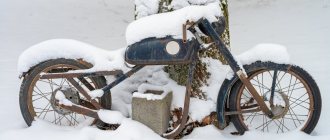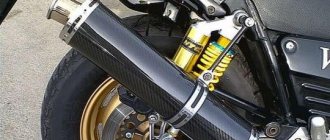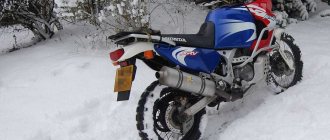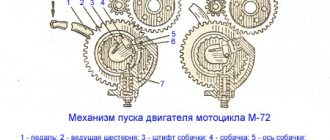If you know the slogan “Let freedom ride”, and the name Jackson Teller is not an empty phrase for you, then this article is for you. There are no former motorcyclists: once you feel the spirit of freedom, you will invariably strive for it again and again: the roar of a classic American engine, the wind flying into the sleeves of a biker jacket, and the empty highway ahead... Wait, maybe this is not your story at all? Maybe you are one of those who are used to seeing only a three-digit number on the speedometer and hearing not a roar, but the incomparable roar of Japanese engines? Kawasaki or Harley Davidson, Yamaha or Indian, any motorcycle deserves care and proper storage. We'll tell you how to properly store your bike and where it's best to do it.
Seasonal motorcycle storage: main features
Even if you know all the intricacies of preserving motorcycle equipment for the winter, the question of storing a motorcycle always makes every self-respecting motorcyclist think. Here the selection of options begins: a garage, a parking lot, a street, a shed in the country, in the end - where to choose your favorite bike? We must remember that the main enemy of any motorcycle is moisture. In a matter of days, it can begin corrosive processes, which will then be very difficult to get rid of. Temperature changes and cold also have a bad effect, so winter storage of a motorcycle is a separate topic that deserves detailed instructions, in addition to the fact that we will tell you where you can store a motorcycle in the summer.
www.pinterest.com
7). Check antifreeze
If you will be storing your motorcycle in a place where temperatures may drop below zero, be sure to check the antifreeze level in the cooling system. It is very important! If you fill it with water, you may find a cracked cylinder block when you come to pick up your bike in the spring!
Conservation
Preserving a motorcycle for the winter is its complete maintenance, which includes changing the oil, flushing the gas tank, checking all the wires and much more, which will allow you to immediately get on the bike in the spring and start it halfway.
Don’t rush to the garage, first you should go to the store and buy everything you need to process the motorcycle. This:
- Silicone Grease;
- spray for metal surfaces, or more simply put, the well-known “Vedashka” WD-40;
- chain lubricant;
- wax polish or simple lubricant;
- new motor oil;
- rags;
- a can of gasoline;
- additive for cleaning the fuel system.
Let's start with the hottest thing - gasoline! Leaving a motorcycle with a half-empty tank for the winter means dooming it to inevitable corrosion, don’t do that. The motorcycle should be preserved with a filled tank so that condensation does not appear on its walls, causing corrosion.
Need I say that it is better to refuel with high-quality gasoline with the octane number for which the engine is designed? Take the time and money to find proven fuel. If you are not sure about the gasoline that is splashing around in the gas tank, then it is better to drain it completely and fill it with good, high-quality fuel. Since gasoline, like any other hydrocarbons, is unstable and decomposes after some time, and higher fractions quickly evaporate, the shelf life of gasoline at gas stations does not exceed 30 days. What to do? You can add a fuel stabilizer to gasoline or a special additive to clean the fuel system - this can be done right at the gas station, without leaving the cash register, as they say, or rather, from the motorcycle.
Then the motorcycle needs to be washed. Here you can go two ways: do everything yourself in the garage or go to a car wash. Just not contactless! In most cases, they use products with very aggressive alkaline compounds that do not provide a protective coating and do not wash away dirt and hard-to-reach places. This means that it is in them that corrosion will appear. Use products with protective wax for hand washing motorcycles - these shampoos are specially created to ensure that the bike's coating does not deteriorate, does not rust, and remains clean for as long as possible. After a refreshing shower, we wipe the bike dry - everything is like people do.
Now you need to process the main nodes. We lubricate all cables, hinges and handles with engine preservation spray or universal WD-40. Particular attention should be paid to the front fork and lubricate the chrome feathers.
Next we protect the electrical wiring. The main enemies of wiring: sub-zero temperatures (terminals oxidize), humidity and dampness (materials wear out), rodents (gnaw and damage wires). A special spray for treating electrical wiring will protect you from all these problems: it lasts for just six months, and for every firefighter, we spray high-voltage wires with a spray against rodents - the smell will scare them away, not even allowing them to try the wires. Silicone lubricant will protect the rubber from hardening, cracking and aging.
Tire treatment cannot be skipped if you want the rubber to last for a long time: in the winter, be sure to treat it with special foam. The motorcycle's rubber is special, its composition is soft, so that the bike has high grip on the road when turning and leaning. It hardens and dries quickly, so regular silicone will not work here. Tire foam will keep the rubber as soft and wear-resistant. And don’t forget about the tire pressure: it must be reduced to 0.5 atmospheres.
Removing the battery. At this stage, even the most seasoned biker will wipe away a stingy tear: we disconnect the motorcycle from the power supply, that is, we remove the battery. If you do not remove the battery, but simply decide to remove the terminals from it, then treat them with a protective spray to prevent corrosion.
4). Prepare the fuel system
Fill the tank with gasoline until the tank is full so that there is almost no air in it, as condensation may appear there and the tank will gradually begin to rust. Add fuel stabilizer to gasoline. Before the new season, it is better to drain this “old” gasoline and refuel with new one.
Where is the best place to store a motorcycle?
You need to choose a storage location carefully - it should be safe, warm and ventilated. We don’t consider options for storing a motorcycle on the balcony, landing, in the front door, under the mother-in-law’s bed, in a missile warehouse, or in the basement of a nearby store - all this is not serious. Any self-respecting motorcyclist will make every effort to take the best possible care of his equipment. Let's go through the most common storage options and see where it is best to keep a motorcycle.
Battery preparation
To store motorcycles in winter, the battery must be fully charged, then removed, taken to a dry, cool room and recharged once every month and a half.
If the motorcycle has any elements that require constant access to electricity, then leave the battery on the motorcycle, but do not forget to check the charge level from time to time. This will help avoid battery failure due to prolonged inactivity.
It is also important to completely drain the engine oil and clean it of all debris and sludge. This prevents crankcase sediment, which can fall from the suspension of various particles in the contaminated oil.
It is also advisable to drain the brake fluid so that it does not corrode the insides and hoses. Gearbox transmission oil loses its properties during long-term storage and needs to be disposed of.
All the steps that will be given below are extremely important and their neglect can lead to disastrous consequences!
PS Attentive readers will have a legitimate question. So much has been done for conservation, but what to do with all this in the spring? It’s very simple: the listed preservatives do not need to be removed. All you have to do is pump up the tires, wash the bike, start it and you’re good to go!
Street
The simplest option in every sense is to chain your iron friend to the bars under the windows of your home. Of course, you will need a good strong chain or a special anti-theft bracket with an alarm, a case, as well as constant supervision of the motorcycle. This will not protect the motorcycle from vandals, bad weather or theft, but if you are lucky, the money saved from paid parking or garage rental will be able to buy new protection for the next season. If, of course, there is still anything left of the motorcycle.
Winter⛔
Summer✅
Pros: free, motorcycle is always at hand.
Cons: unsafe; in bad weather it will begin to deteriorate.
2). Changing oil and filters
Changing the oil and filters is extremely important for the lubrication system. It is much better to have fresh oil and new filters in it if the motorcycle will not be used for several months. By replacing new oil, you will prevent system blockages and dangerous oxides, cleanse the entire system of unnecessary toxins with this oil and increase the protection of the engine itself. It is advisable to change the oil in the fall for one more reason, but for this reason, would you want to change the oil at the very beginning of the season, when your hands are already itching to start your motorcycle and ride faster? You probably won't want to? That's it!
Garage
An unheated garage is harsh, but better than outside, and your two-wheeled friend will definitely say “thank you!” for a heated garage. In the garage, the motorcycle will no longer be covered with snow and it will not get wet in the rain, however, when stored in a cold room, the spark plugs may turn sour - they should be unscrewed in advance; in a warm garage there will be no such problems. Motorcyclists are a strong community and are used to helping each other and helping out in difficult times. Therefore, many bikers pool together to rent a garage for their car in order to put several bikes there at once: it’s both cheaper and easier.
Winter✅
Summer✅
Pros: under a roof, under lock and key.
Cons: in an unheated garage, even a motorcycle prepared for preservation is not protected from corrosion.
6). Preserve your tires for the winter
Tire storage is another important point in our tips. If you leave the motorcycle on a stand and it stands for a long time in the same place, then the tires themselves will be pressed through at the point of contact with the surface on which the motorcycle was standing. To prevent this from happening, there are two options. First, you need to buy special stands for the front and rear wheels. The second, preferable option, is to remove the wheels and take them home, and then store them at home, but only in a lying position. At the same time, the motorcycle itself without wheels must be placed in such a way that its suspension is not completely unloaded and the fork legs do not come completely out of the pants. This will prevent possible suspension problems in the future.
Paid parking
This is one of the safest options: for a relatively small fee, the motorcycle will be under supervision 24/7 and no one will be able to encroach on your property without permission. Unfortunately, rain, snow, low temperatures and humidity will undoubtedly have a negative impact on the condition of the motorcycle in an open parking lot. Heated parking is the answer to the question: “Where to store a motorcycle in the city?” Ideal climate, security and the opportunity to visit your friend at any time.
Winter✅
Summer✅
Pros: safe and ideal storage conditions.
Cons: high price and danger of corrosion in the case of open parking.
Container
A motorcycle storage container is a sealed metal box that is quite mobile (can be moved if necessary) and sealed. All the pros and cons in one bottle. Yes, it’s easy to install a container in your local area, but intruders can also do this - that is, take and drag away your container along with the motorcycle inside. Airtightness, on the one hand, seems like a plus - it protects against weather conditions, but in reality, the lack of ventilation can contribute to improper humidity, condensation, mold, etc. Ventilation is an important point when storing a motorcycle for a long time.
Winter✅
Summer✅
Pros: the container is easy to install and move by yourself, protects from snow and rain.
Cons: not heated, not ventilated, not very reliable.
Necessary measures
- Pre-wash and dry. After the motorcycle is washed, it is necessary to thoroughly wipe it with a rag and blow out the electrical connectors and all connections with compressed air.
- An oil change is necessary to ensure that the internal metal surfaces of the engine are not damaged by acid emissions that appear during the combustion process.
- There should be some fresh fuel mixed with stabilizer in the tank.
- The cylinders also need to be lubricated to prevent rust. Gasoline is a solvent; before cranking the starter, turn off the fuel and distribute the oil evenly among the cylinders.
- Remove the battery.
- Spray the frame, engine and other metal surfaces with a protective preservative liquid. It protects transport from moisture and temperature influences.
- Tires must be properly inflated.
- Spray the ends of the muffler and drain holes with WD-40.
All these actions are necessary if you want to “sit down and go” in the spring, and not bother with repairs for another couple of months.











